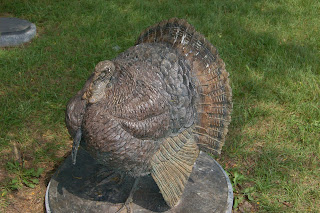The weather remained clear so we took off on the bike for the Genesee County Village and Museum. After a pleasant hour of scenic riding, we arrived at this extensive living history village. The village consists of historic buildings moved from all over the area. What makes this village different is that it is divided into three different time periods spanning a century and a half in time. The self guided tour starts with three exhibition buildings outside the village with exhibits spanning the same time period. The first is the John L. Wehle Gallery. Mr. Wehle is the reason that the village exists. Inside is a collection of vehicles, paintings and sculptures depicting popular outdoor sporting events over the last century, including carriage driving for gentlemen, big game hunting, trophy fishing.
This carriage is called a four in hand because the four reigns controlling the four horses are all held in one hand. Gentlemen could prove their prowess by driving at a trot through the park or "drag" racing on the street. I guess it could be compared to the difference between a chauffeur driven car and a gentleman driving his sports car.
Scattered around the lawn in front of the gallery are several life-sized and life-like sculptures--mountain lion
bears
a flock of turkeys presided over by this beautiful male
The Exhibition Barn featured a collection of fabrics and clothing, some hand made, some manufactured. This particular exhibit displayed clothing described in popular literature such as The Legend of Sleepy Hollow, Sherlock Holmes, Tom Sawyer, etc. A fan of vintage fabric and clothing, I spent a lot of time in here.
The third building was the carriage museum, but the floor was empty. The smaller gigs and sleds were suspended from the ceiling and difficult to photograph. We suspected that more work was in the offing.
After these three buildings, we actually entered the first part of the village, the Pioneer Settlement dating from the 1780's through the 1830's. The buildings here were smaller, more primitively finished, and the business providing the necessities such as farm school, blacksmith, brewery.
This is a sparsely furnished blacksmith shop with only 20 or so pairs of tongs, and 5 or 6 hammers.
Next was the Antebellum Village with a time period of 1830's-1860's. With the completion of the Erie Canal, trade goods are more easily accessible so that houses are nicer and more comfortably furnished.
This dining room features a hearth with a beehive oven--the front is the little square on the right.
This kitchen is very large and modern with a built in laundry tub on the right, an ironing board and the back of the beehive oven in addition to the kitchen hearth, and sink.
This general store is able to provide a wide variety of dishes, spices, hardware etc. in very nice displays.
Any guesses?
This is a horse or carriage mount. Also note the sidewalk.
Other business included this gunsmith's shop, pottery shop, drug store, dressmaker's shop, printing office, and boot/shoemaker. Personal services included offices for a physician, lawyer, insurance salesman, and a couple of churches.
Most building were not painted on the outside during this time period but log houses were covered with some kind of siding. The village also featured an orchard, and a village square.
.
The Turn of the Century Village was small but accurately demonstrated the 1870's through 1920's. This was an age of enlightenment with printed books bringing in new ideas and innovations in.
The Hyde's were very modern in their thinking. They believed in spiritualism and made their house in an octagonal so that evil spirits could not hide in the corners. The houses of this time period were as large as incomes allowed with modern conveniences/innovations such as running water and an ice box in the kitchen, wall-to-wall padded carpet, flocked wallpaper, paintings, sculptures, gas chandeliers, modern appliances etc. all shipped by railroads and carted over improved roads.
The grounds around this house also held a carriage house, ice house and a windmill.
Reproduction quilt and crocheted coverlet in traditional designs.
Notice the wallpaper and window shades.
We quite enjoyed our day long ramble through history. We would rate this as a must-see if you are in the area. Some of the buildings were not open for view for various reasons, but all in all the village was very enjoyable. A few of the buildings were "repurposed". A couple held info-board displays. A couple provided food and drinks. We very much appreciated these as we didn't bring any and the day was rather warm. This village was our last scheduled place to visit. Hopefully we will get in a bike ride or two.
Stay tuned!
Louise and Duane
















1 comment:
What a great museum. I always wondered why people built round houses. Now I know...those dang evil spirits.
Post a Comment